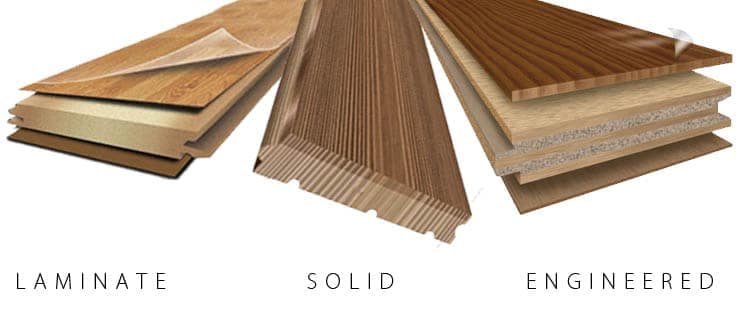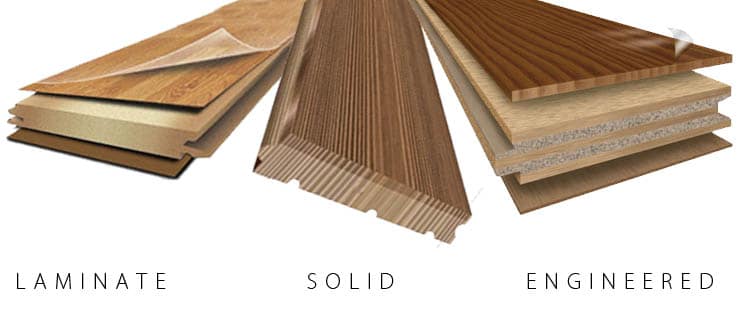
The selection of flooring material is very important for an owner, as it is the flooring which adds up the elegance factor to the interior of any home.
Wood flooring is considered one of the most ancient types of floorings. While installing wood flooring there arises a confusion between various wood flooring types. A homeowner must consider the differences among solid vs engineered vs laminate wood flooring, so as to buy the best option among these.
When we compare solid vs engineered vs laminate wood flooring all have their own pros and cons that should be considered before installing as well as renovating your flooring. Here we give a brief comparison of wood flooring types, to help you make the right choice.

Solid vs Engineered vs Laminate Wood Flooring
01. Composition
Solid Wood Flooring
- The flooring is made from a single piece of natural wood.
Engineered Wood Flooring
- It is made with a top layer of solid wood fused with several layers of plywood.
Laminate Wood Flooring
- It uses a photographic image of wood on a decor paper adhered to a medium density fiberboard.
01. Properties
(a) Durability
Solid Wood Flooring
- Solid wood flooring has durability of the lifetime or even more.
Engineered Wood Flooring
- It has less durability than solid wood flooring, but it can last for lifetime if proper care is taken.
Laminate Wood Flooring
- Laminate wood flooring has a durability of around 30 years, after that it has to be replaced
(b) Thickness
Solid Wood Flooring
- It has a general thickness 18 mm to 20 mm.
Engineered Wood Flooring
- Engineered wood flooring has a thickness of 8 mm to 15 mm.
Laminate Wood Flooring
- Laminate wood flooring has a thickness of 6 mm to 15 mm.
(c) Resistance to Scratches
Solid Wood Flooring
- Solid wood flooring has very low resistance to scratches. It can be scratched very easily.
Engineered Wood Flooring
- It has a relatively high resistance to scratch as compared to solid wood flooring.
Laminate Wood Flooring
- It has very high resistance to scratches, due to protective layer provided on the top.
(d) Dimensional Stability
Solid Wood Flooring
- It is made of natural wood which is a hygroscopic material thus, it will expand when in contact with moisture and like-wise contract when in a dry state.
Engineered Wood Flooring
- Its plywood base is dimensionally stable and thus engineered wood flooring warps relatively less as compared to solid wood flooring
Laminate Wood Flooring
- As laminate wood flooring does not have natural wood, it is has more dimensional stability and does not warps in presence of moisture.
03. Installation
Solid Wood Flooring
- Its installation is relatively complex as compared to other wood flooring types.
Engineered Wood Flooring
- Depending upon the installation method, it requires moderated level of expertise.
Laminate Wood Flooring
- It is very easy to install and no skilled person is required. It can be easily glued to any existing surface which is properly leveled
04. Noise Production
Solid Wood Flooring
- As wood is hollow, solid wood flooring produces more noise on walking as compared to other wood flooring types.
Engineered Wood Flooring
- Engineered wood flooring produces less noise as compared to solid wood flooring.
Laminate Wood Flooring
- Laminate wood flooring produces least noise. It is prominently used where sound proof room is desired.
05. Maintenance
Solid Wood Flooring
- Regularly cleaning with vacuum cleaner and a damp cloth is sufficient. Occasionally wood cleaner can be used.
Engineered Wood Flooring
- Similar to solid wood flooring, engineered wood flooring also requires a considerable amount of maintenance.
Laminate Wood Flooring
- Laminate wood flooring is very easy to maintain as it requires minimal cleaning. No special cleaner is to be used.
06. Repair
Solid Wood Flooring
- Solid wood flooring can be repaired easily by sanding and staining several times during its use.
Engineered Wood Flooring
- As engineered wood flooring has only top layer of real wood, which can be sanded once or twice during its lifetime, after that it has to be replaced.
Laminate Wood Flooring
- Laminate wood flooring cannot be sanded as it does not have any real wood. If damaged the planks are to be replaced.
07. Resale Value
Solid Wood Flooring
- Solid wood flooring is considered as a valuable asset for your house. It resale value is very excellent.
Engineered Wood Flooring
- Engineered wood flooring also has high resale value as it has a layer of solid wood in it.
Laminate Wood Flooring
- Laminate wood flooring does not give high resale value as it is a synthetic product and no real wood is used in it.
08. Application Area
Solid Wood Flooring
- Except in areas where there is high moisture content such as kitchen, bathrooms and basements, solid wood flooring can be installed in any room of your house.
Engineered Wood Flooring
- Due to dimensionally stable nature, it can be installed even in kitchen areas, apart from other rooms of your house.
Laminate Wood Flooring
- Laminate wood flooring can be installed anywhere in your house including basements except wet areas like bathrooms and laundry rooms
09. Advantages
Solid Wood Flooring
- A variety of wood species with different textures, colours and patterns are available to choose from.
- If a particular plank is damaged solid wood flooring can be easily replaced without disturbing the entire flooring.
- As solid wood flooring can be easily repaired by sanding several times, it is preferred in high traffic areas.
Engineered Wood Flooring
- Engineered wood flooring uses only a top layer of solid wood, saving natural wood. Also, the plywood layers use scrap wood minimizing waste material. So it is an eco-friendly option.
- It can be installed in kitchen areas and in basements, as it is more dimensionally stable.
- It comes in pre-finished form, which has high resistance to scratches as compared to solid wood flooring.
Laminate Wood Flooring
- It gives your home look of natural wood at a cheap cost.
- As laminate wood flooring uses photographic image of wood on décor paper, you can make custom design for your flooring.
- It can be easily installed over any existing flooring, except carpets.
- Laminate planks do not require any acclimation time, as in case of other wood flooring types and hence can be installed quickly.
10. Disadvantages
Solid Wood Flooring
- It has very low resistance to scratches. So if you have pets in your home, installing solid wood flooring is not recommended.
- Solid wood expands in monsoon and contracts in summer, thus expansion joints have to be provided.
- It swells in wet conditions, so it is not recommended to install it in bathrooms, kitchen and basements.
Engineered Wood Flooring
- Engineered wood flooring can be repaired only once or twice, thus it is not recommended for high traffic areas.
- If solid wood and plywood are not glued properly, it can cause cracks as both the materials respond differently to temperature changes.
- Even though it is more dimensionally stable, it cannot be installed in wet areas like bathrooms and laundry rooms.
Laminate Wood Flooring
- Laminate wood flooring only gives appearance of real wood, but does not give feel and warmth of real wood.
- Laminate wood flooring becomes slippery when wet.
- It cannot be repaired by sanding, if damaged planks have to be replaced.
11. Cost
Solid Wood Flooring
- Solid wood flooring generally costs INR 500/sqft to INR 1000/sqft.
Engineered Wood Flooring
- Engineered wood flooring costs INR 200/sqft to INR 500/sqft.
Laminate Wood Flooring
- Laminate wood flooring costs INR 80/sqft to INR 150/sqft.
Also Read:


































